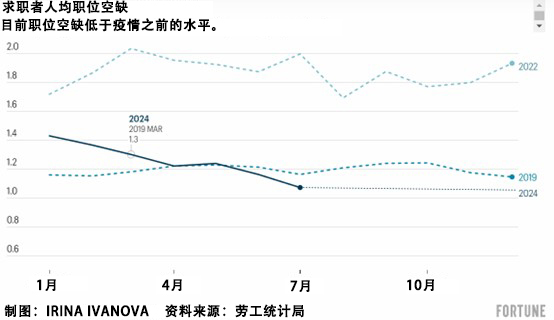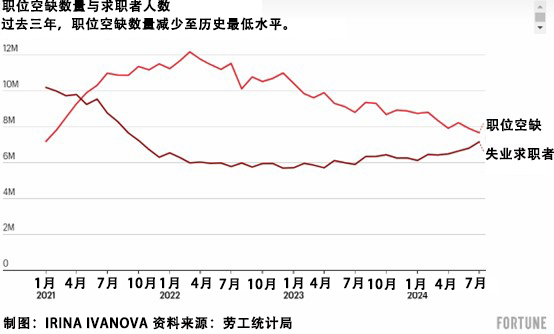
今年7月,美国雇主发布的职位空缺数量少于上个月,这意味着招聘突然降温,而且职位空缺未来几个月可能进一步减少。
美国劳工部周三公布的报告显示,7月份的职位空缺为770万个,少于6月份的790万个,为2021年1月以来的最低水平。今年,美国的职位空缺从1月份的近880万个持续减少。
裁员人数从156万增加到176万,达到自2023年3月以来的最高水平,但这与疫情之前的裁员水平一致,当时美国的失业率处于历史低位。在经历过疫情期间的衰退后,美国经济快速复苏,因此裁员人数不同寻常地处于较低水平,许多雇主希望留住现有员工。
英迪德招聘实验室(Indeed Hiring Lab)的研究总监尼克·邦克表示:“劳动力市场不仅仅是逐步降温,达到疫情之前的水平,而是会比疫情之前更加低迷。在这个重要关头,包括美联储的政策制定者在内,没有人想看到劳动力市场进一步降温。”邦克指出,目前职位空缺与失业的求职者的比例,低于2019年的水平,就业市场持续降温可能意味着更多人将被裁员。

总体而言,周三发布的报告呈现出来的就业市场状况令人喜忧参半。一方面,总聘用人数在6月份降至四年最低的520万人之后,7月增长至550万人。辞职人数小幅增长至约330万人。辞职人数被视为衡量就业市场健康状况的一个指标:工作者通常会在已经找到新工作或者有信心找到新工作时才选择辞职。
辞职人数依旧远低于2022年450万人的最高点。当时,在经历过疫情导致的经济衰退之后,美国经济正在加快复苏,因此许多上班族选择了换工作。当时辞职人数激增,帮助刺激了工资上涨,因为许多公司为了找到或留住员工,纷纷加薪。目前辞职人数较少,意味着工资可能维持适度上涨,这将有助于继续降低通胀。
桑坦德银行(Santander)的经济学家史蒂芬·斯坦利指出,7月份的职位空缺依旧比招聘状况较为健康的2019年高约7%。他说道:“劳动力需求依旧强劲,只是增速有所放缓。”
消费者继续支出,但企业在减少招聘
周三公布的数据表明,尽管近期数据显示消费者支出维持增长势头,但很少有公司正在寻求增加员工。上周,美国政府估计,4月至6月这一季度,美国经济维持了健康的3%的年增长率。
7月,医疗保健和州与地方政府的职位空缺大幅减少,仓储和交通运输行业的职位空缺同样有所减少。制造业和专业服务与商务服务行业(包括法律服务和工程与会计等领域)的职位空缺增多。
尽管过去两年职位空缺有所减少,但目前每个失业者依旧有约1.1个职位空缺,这与疫情之前的情况相反,当时失业人数几乎始终多于提供的工作岗位。

7月份的职位空缺报告是本周最早发布的衡量劳动力市场健康状况的指标,美联储将密切关注这些指标。如果有确切证据表明招聘低迷,美联储可能在9月17日至18日的下一次会议上决定下调基准利率,降幅将是相对激进的50个基点。但如果招聘情况依旧稳健,美联储更有可能像往常一样将利率下调25个基点。
周四,美国政府将公布上周有多少被裁员的上班族申请失业补助。迄今为止,大多数雇主主要是在努力留住员工,而不是进行裁员,只是与今年早些时候相比,他们放慢了增加工作岗位的速度。
周五,本周最受关注的经济报告“月度就业数据”即将发布。经济学家们一致估计,8月雇主新增163,000个就业岗位,失业率从4.3%小幅下降到4.2%。
上个月,美国政府公布的报告显示,7月份就业岗位增长速度放缓,仅新增了114,000个就业岗位(远不及预期,而且这是三年半以来新增就业岗位数量第二低的一个月份),而且失业率连续四个月上升。
这些数字引发了人们对经济严重疲软的担忧,并导致股价暴跌。
ZipRecruiter首席经济学家茱莉亚·波拉克表示:“就业报告数据下滑,职位空缺与劳动力流动调查报告中的指标下滑,这表明劳动力市场不再是通胀压力的来源,而且降息的时机在7月份就已经到来或者说早已成熟。”
上个月晚些时候,美联储主席杰罗姆·鲍威尔强调,随着通胀逐步降温,美国央行日益重视就业市场的状况。
在怀俄明州杰克逊霍尔召开的年度经济研讨会上,鲍威尔在发言中表示,招聘“大幅降温”,美联储不会“寻求或者欢迎”就业市场“进一步降温”。经济学家们认为这些言论表明,如果美联储确定需要抵消招聘下滑的影响,它可能会加快降息。(财富中文网)
译者:刘进龙
审校:汪皓
今年7月,美国雇主发布的职位空缺数量少于上个月,这意味着招聘突然降温,而且职位空缺未来几个月可能进一步减少。
美国劳工部周三公布的报告显示,7月份的职位空缺为770万个,少于6月份的790万个,为2021年1月以来的最低水平。今年,美国的职位空缺从1月份的近880万个持续减少。
裁员人数从156万增加到176万,达到自2023年3月以来的最高水平,但这与疫情之前的裁员水平一致,当时美国的失业率处于历史低位。在经历过疫情期间的衰退后,美国经济快速复苏,因此裁员人数不同寻常地处于较低水平,许多雇主希望留住现有员工。
英迪德招聘实验室(Indeed Hiring Lab)的研究总监尼克·邦克表示:“劳动力市场不仅仅是逐步降温,达到疫情之前的水平,而是会比疫情之前更加低迷。在这个重要关头,包括美联储的政策制定者在内,没有人想看到劳动力市场进一步降温。”邦克指出,目前职位空缺与失业的求职者的比例,低于2019年的水平,就业市场持续降温可能意味着更多人将被裁员。
总体而言,周三发布的报告呈现出来的就业市场状况令人喜忧参半。一方面,总聘用人数在6月份降至四年最低的520万人之后,7月增长至550万人。辞职人数小幅增长至约330万人。辞职人数被视为衡量就业市场健康状况的一个指标:工作者通常会在已经找到新工作或者有信心找到新工作时才选择辞职。
辞职人数依旧远低于2022年450万人的最高点。当时,在经历过疫情导致的经济衰退之后,美国经济正在加快复苏,因此许多上班族选择了换工作。当时辞职人数激增,帮助刺激了工资上涨,因为许多公司为了找到或留住员工,纷纷加薪。目前辞职人数较少,意味着工资可能维持适度上涨,这将有助于继续降低通胀。
桑坦德银行(Santander)的经济学家史蒂芬·斯坦利指出,7月份的职位空缺依旧比招聘状况较为健康的2019年高约7%。他说道:“劳动力需求依旧强劲,只是增速有所放缓。”
消费者继续支出,但企业在减少招聘
周三公布的数据表明,尽管近期数据显示消费者支出维持增长势头,但很少有公司正在寻求增加员工。上周,美国政府估计,4月至6月这一季度,美国经济维持了健康的3%的年增长率。
7月,医疗保健和州与地方政府的职位空缺大幅减少,仓储和交通运输行业的职位空缺同样有所减少。制造业和专业服务与商务服务行业(包括法律服务和工程与会计等领域)的职位空缺增多。
尽管过去两年职位空缺有所减少,但目前每个失业者依旧有约1.1个职位空缺,这与疫情之前的情况相反,当时失业人数几乎始终多于提供的工作岗位。
7月份的职位空缺报告是本周最早发布的衡量劳动力市场健康状况的指标,美联储将密切关注这些指标。如果有确切证据表明招聘低迷,美联储可能在9月17日至18日的下一次会议上决定下调基准利率,降幅将是相对激进的50个基点。但如果招聘情况依旧稳健,美联储更有可能像往常一样将利率下调25个基点。
周四,美国政府将公布上周有多少被裁员的上班族申请失业补助。迄今为止,大多数雇主主要是在努力留住员工,而不是进行裁员,只是与今年早些时候相比,他们放慢了增加工作岗位的速度。
周五,本周最受关注的经济报告“月度就业数据”即将发布。经济学家们一致估计,8月雇主新增163,000个就业岗位,失业率从4.3%小幅下降到4.2%。
上个月,美国政府公布的报告显示,7月份就业岗位增长速度放缓,仅新增了114,000个就业岗位(远不及预期,而且这是三年半以来新增就业岗位数量第二低的一个月份),而且失业率连续四个月上升。
这些数字引发了人们对经济严重疲软的担忧,并导致股价暴跌。
ZipRecruiter首席经济学家茱莉亚·波拉克表示:“就业报告数据下滑,职位空缺与劳动力流动调查报告中的指标下滑,这表明劳动力市场不再是通胀压力的来源,而且降息的时机在7月份就已经到来或者说早已成熟。”
上个月晚些时候,美联储主席杰罗姆·鲍威尔强调,随着通胀逐步降温,美国央行日益重视就业市场的状况。
在怀俄明州杰克逊霍尔召开的年度经济研讨会上,鲍威尔在发言中表示,招聘“大幅降温”,美联储不会“寻求或者欢迎”就业市场“进一步降温”。经济学家们认为这些言论表明,如果美联储确定需要抵消招聘下滑的影响,它可能会加快降息。(财富中文网)
译者:刘进龙
审校:汪皓
America’s employers posted fewer job openings in July than they had the previous month, a sign that hiring is cooling sharply and could drop further in coming months.
The Labor Department reported Wednesday that there were 7.7 million open jobs in July, down from 7.9 million in June and the fewest since January 2021. Openings have fallen steadily this year, from nearly 8.8 million in January.
Layoffs rose from 1.56 million to 1.76 million, the most since March 2023, though that level of job cuts is roughly consistent with pre-pandemic levels, when the unemployment rate was historically low. Layoffs have been unusually low since the economy’s rapid recovery from the pandemic recession, with many employers intent on holding onto their workers.
“The labor market is no longer cooling down to its pre-pandemic temperature, it’s dropped past it. Nobody, and certainly not policymakers at the Federal Reserve, should want the labor market to get any cooler at this point,” said Nick Bunker, research director at the Indeed Hiring Lab. Bunker noted that the ratio of open jobs to unemployed job-seekers is now below where it was in 2019, and any further cooling in the job market would likely mean more layoffs.
Overall, Wednesday's report painted a mixed picture of the job market. On the positive side, total hiring rose in July, to 5.5 million, after it had fallen to a four-year low of 5.2 million in June. And the number of people who quit their jobs ticked up slightly, to about 3.3 million. The number of quits is seen as a measure of the job market’s health: Workers typically quit when they already have a new job or when they're confident they can find one.
Still, quits remain far below the peak of 4.5 million reached in 2022, when many workers shifted jobs as the economy accelerated out of the pandemic recession. The spike in quits at that time helped drive up wage gains as companies jacked up pay to try to find or keep employees. The current lower level of quits suggests that wage increases will likely remain modest, which should help further cool inflation.
Stephen Stanley, an economist at Santander, noted that July's job openings are still about 7% above 2019 levels, when hiring was healthy. “Labor demand is still solid, albeit moderating,” he said.
Consumers spend, but businesses halt hiring
Wednesday's figures indicate that fewer companies are seeking to add workers despite recent data showing that consumer spending is still growing. Last week, the government estimated that the economy expanded at a healthy 3% annual rate in the April-June quarter.
In July, job openings fell sharply in health care and state and local government and also dropped in warehousing and transportation. Openings rose in manufacturing and professional and business services, a category that includes legal services and engineering and accounting.
Even as openings have fallen for the past two years, there are still roughly 1.1 job openings for every unemployed person—a reversal from before the pandemic, when there were nearly always more unemployed people than available jobs.
The July report on job openings is the first of several measures this week of the labor market's health that the Federal Reserve will be watching closely. If clear evidence emerges that hiring is faltering, the Fed might decide at its next meeting Sept. 17-18 to start cutting its benchmark interest rate by a relatively aggressive half-percentage point. If hiring remains mostly solid, however, a more typical quarter-point rate cut would be likelier.
On Thursday, the government will report how many laid-off workers sought unemployment benefits last week. So far, most employers are largely holding onto their workers, rather than imposing layoffs, even though they have been slower to add jobs than they were earlier this year.
On Friday, the week’s highest-profile economic report — the monthly jobs data — will be released. The consensus estimate of economists is that employers added 163,000 jobs in August and that the unemployment rate ticked down from 4.3% to 4.2%.
Last month, the government reported that job gains slowed in July to just 114,000 — far fewer than expected and that the second-smallest total in 3 1/2 years — and the unemployment rate rose for a fourth straight month.
Those figures sparked fears that the economy was seriously weakening and contributed to a plunge in stock prices.
"Together with slipping Jobs Report figures, sliding JOLTS Report indicators provide evidence that the labor market is no longer a source of inflationary pressure, and that the time to cut interest rates has arrived—or rather, had already arrived in July," Julia Pollak, chief economist at ZipRecruiter, said.
Late last month, Fed Chair Jerome Powell underscored the central bank’s increasing focus on the job market, with inflation steadily fading.
In a speech at an annual economic symposium in Jackson Hole, Wyoming, Powell said that hiring has “cooled considerably” and that the Fed does not “seek or welcome further cooling” in the job market. Economists saw those comments as evidence that the Fed may accelerate its rate cuts if it decides it is needed to offset a slowdown in hiring.






